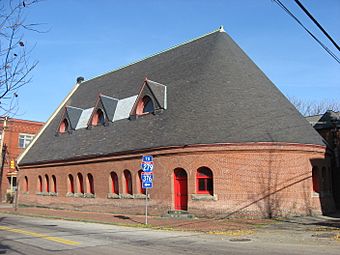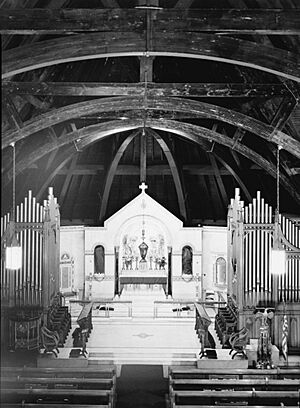Emmanuel Episcopal Church (Pittsburgh, Pennsylvania) facts for kids
|
Emmanuel Episcopal Church
|
|

Emmanuel Episcopal Church
|
|
| Location | 957 W. North Ave., Pittsburgh, Pennsylvania |
|---|---|
| Area | 0.5 acres (0.20 ha) |
| Built | 1886 |
| Architect | Henry Hobson Richardson |
| Architectural style | Romanesque Revival, Richardsonian Romanesque |
| NRHP reference No. | 74001737 |
Quick facts for kids Significant dates |
|
| Added to NRHP | May 3, 1974 |
| Designated NHL | February 16, 2000 |
The Emmanuel Episcopal Church is a beautiful church located in the North Side neighborhood of Pittsburgh, Pennsylvania. You can find it at 957 West North Avenue. This church building was finished in 1886. It is famous because it was one of the last buildings designed by a well-known architect named Henry Hobson Richardson. Because of its special design, it was named a National Historic Landmark in 2000. Today, it's still an active church and is known for its Sunday evening Jazz Vespers services.
Even though bricks were chosen to save money, the brickwork is one of the church's most amazing parts. Unlike many of Richardson's other buildings, Emmanuel Episcopal has smooth walls. They don't have rough surfaces or many decorations that stick out. However, the bricks do stick out a little bit just below the roofline. This creates a nice decorative line. Stone is only used for window sills and around the three main entrance arches.
The church's simple look is made more interesting by patterns in the bricks. For example, there's a cool triangle pattern at the roofline called "mousetooth." This brick pattern makes the walls look like finely woven fabric. The deeply set windows and doors create dramatic dark spaces.
One of the most famous things about Emmanuel Episcopal Church is actually a mistake! The bottom part of the western wall was supposed to lean inward as it went up. This architectural feature is called battering. But instead, the wall started to bow outward soon after it was built. Richardson died a month after the church was finished. So, the church hired his old employees to try and fix the problem. They couldn't figure out why it was happening. However, when a new building called the parish house was added next to the church, the wall stopped bowing out more.
History of the Church
The Emmanuel Episcopal Church started in 1867. It began as a mission to provide a Sunday school for the children of English workers. At first, they met in people's homes, then in rented rooms. The number of members grew to 76 people by 1868. That year, they officially became a church. The very next year, they built a simple wooden church building.
By 1875, the area around the church became very popular, and the wooden church was too small. A special committee was formed in 1882 to plan a new church. In 1883, they bought the land for the new church for $750. Henry Hobson Richardson was chosen as the architect in January 1884. At the same time, he was also designing the famous Allegheny County Courthouse and Jail in Pittsburgh.
Richardson's first ideas for the church were for a stone building. It would have been about the same size as the church today, but with a tall tower in the middle. This was similar to his design for Trinity Church in Boston. However, the estimated cost of $25,000 was too high for the church members. They decided not to use those plans. The new budget was set at $12,000. So, plans for a smaller brick church were approved instead. The church was built between 1884 and 1886 by Henry Shenk. It was officially opened in March 1886.
Over the next 20 years, the neighborhood changed. Large fancy houses were torn down, and new homes for working-class families were built. Because the church didn't have much money, it wasn't updated or fixed up for many years.
Church Architecture
The Emmanuel Episcopal Church is considered one of the best later works by architect H.H. Richardson. Its simple design looks lively because of the detailed brickwork. The building is a single story and shaped like a rectangle. It has a rounded end called an apse. The church measures about 49 feet 4 inches by 100 feet 0 inches.
The walls are made of red brick with several subtle patterns. The most detailed patterns are on the triangular end of the roof, called the gable. The rounded apse continues around the outside wall at the other end of the building. The bottom parts of the walls, which lean inward, follow the line of the roof. Bands of vertical bricks run along the top and bottom of the windows. The bricks at the edge of the gables are placed at right angles to the roof's slope.
The roof is very steep and covered with slate tiles. It has a decorative copper ridge plate at the top. The steep roof goes down to low side walls. The roof's edge has a three-layer brick design. Three small windows, called dormers, stick out about one-third of the way up the roof on the east and west sides.
The main entrance is on the north side. It has a plain, tall gable and subtly patterned brickwork. There are three low, wide arches, with the middle one being the largest. Above the entrance doors, there are three arched windows made of beautiful Tiffany glass. These windows are taller than the entrance arches. In the center of the third level, there is a narrow slot window with a flat brick arch. Stone steps lead to the large, red wooden double doors. These doors have big, fancy black iron hinges.
Inside, the church is a rectangle with an aisle down the middle. The rounded apse at the south end is partly separated from the main seating area by organ pipes on both sides. At the north end, there's a narrow entrance area called a narthex. A small winding staircase on the west wall leads to the balcony. The narthex is about 10 feet by 44 feet 8 inches. The main seating area, called the nave, is 60 feet 6 inches by 44 feet 8 inches. The apse has a radius of 22 feet 4 inches.
The walls in the chancel (the area near the altar) have marble decorations called reredos. These were made by Leake and Greene of Pittsburgh and include bands of mosaic. In the nave, the walls have wooden panels up to a certain height. Above these panels, pink plaster goes up to a heavily decorated wooden molding near the ceiling. The wooden beams that support the roof are visible.
The side windows have Romanesque stained glass. The triple window above the entrance has Tiffany glass. The floors in the nave are modern vinyl tile, while the chancel has marble floors. During a restoration in 1998, the oak and ash furniture was cleaned and put back. A 3-foot-high (0.91 m) brass cross, given by Bishop Cortlandt Whitehead in August 1886, is still on the altar. The brass eagle lectern, made by Gorham in New York, is also still there. The baptismal font and its cover are also original to the church.
Images for kids






